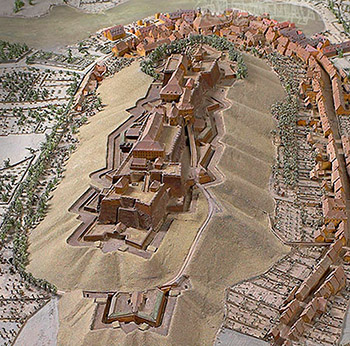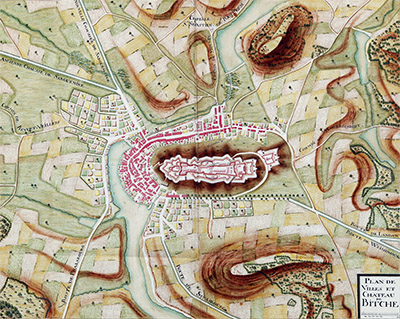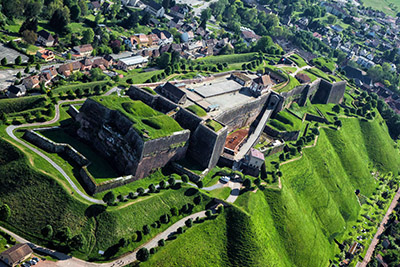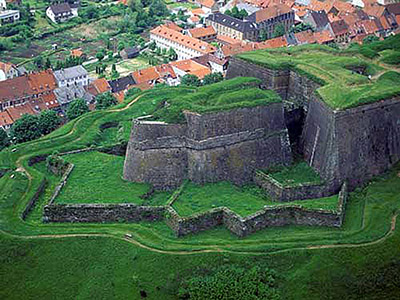 |
Citadelle de Bitche
Bitche, France
|
|
 |
Constructed: 1683-1697, 1741-1765
Used by: France, Prussia
Designed by: Vauban
Conflict in which it participated:
Napoleonic Wars, Franco-Prussian War
|
We don't know whom may have been the first to notice the strategic implications of the impressive hill atop which the Citadelle de Bitche menacingly lurks today (possibly a wooly mammoth), but as is the case with many such European fortified sites, the Romans were the first to name it in a way that has survived to present memory.
The first mention of a fort atop this hill came in 1172, in a document in which a Duke of Lorraine decreed his ownership of the region. It was described as Bytis Castrum, Latin which translates more or less to "fortified place." The passage of time had its inexorable way with this name, and the fort, and surrounding area, became known as Bitche. |
 |
 |
|
Located betwixt the ever-warring Frankish and Germanic lands, the folks who called this region home had good reason to fortify. The boundaries of the many little Lordships, Earldoms and Whathaveyoudoms did not resemble the tidy national borders we see today, and the Lordship of Bitche was the only territory of the Duke of Lorraine that was in a German-speaking area.
Without getting too deep into the interminable semiroyal unions that defined landholdings in medieval Europe, Count Eberhard II of Deux-Ponts married Agnès de Bitche in 1309, giving him the challenging dual titles of Count of Deux-Ponts and Lord of Bitche. As any respectable Lord of Bitche would do, Eberhard took up residence in the Castle de Bitche.
|
Holy Bitche! Just imagine trying to sneak up on that Vaubannian masterpiece! |
 |
By the mid-16th century the Bitches and Lorraines were not getting along, so much so that in 1563 Count Jacques de Bitche purchased the houses that had sprung up close to his castle and had them razed. Jacques then built ramparts along the hill to protect himself from the Dukes of Lorraine to whom, it appears, he owed some money that he did not wish to pay.
Enter Cardinal Richelieu (1585-1642), stage left. Having concluded a recent campaign in Italy in the 1630's, France was looking to expand its eastern border to the Rhine River...and by France I of course mean Cardinal Richelieu. |
|
|
Hoping to retain his lands, Charles IV of Lorraine (1604-1675) made allies with various anti-French entities and opponents of the Cardinal, which unsurprisingly did not endear him to the Cardinal, who dispossessed Charles of many of his lands in 1634. Bitche was captured by the French after a ten-day siege.
The Thirty Years' War (1618-1648) had given France plenty of opportunities to grab plenty of lands around them, and everyone was quite sad when it finally ended. Fortunately the French managed to get into a war with the Dutch and her allies relatively shortly thereafter. The Franco-Dutch War (1672-1678) returned Bitche to the control of those Lorraine folks, but in 1680 the French reappeared and tipped them out of the castle once again.
|
The Castle de Bitche, by this point, wasn't much of a castle any more. Marshal of France Henri de La Tour of Auvergne dit Turenne (1611-1675), better known (fortunately) as simply Turenne, was a Franch badass who had served with distinction in the Thirty Years' and Franco-Dutch Wars. He visited the delapidated Castle de Bitche and was immediately struck by its strategic location. He convinced France's King Louis XIV (1638-1715) that Bitche, as a far-flung outpost of French power, was worthy of Vauban's fortification magic.
If there's one thing I've learned from several years of starfort research, it's that your starfort can't get a much more prestigious descriptive term than, designed by Vauban. Sébastien Le Prestre de Vauban (1633-1707) was the preeminent military engineer of his age. As King Louis XIV's main starforts dude, he directed the construction of 37 starforts around France, and oversaw the upgrade of fortifications in around 300 cities. Vuaban was a busy man, but he somehow found the time to get involved with Bitche.
|
 |
Bitche's coat of arms. Nasty mutant two-headed snake with a crunchy fortified center! |
|
Vauban's masterful work at Bitche took place from 1683 to 1697, and it cost France the astonishing sum of 2,500,000 livre, which amounts to around infinity dollars today. Upon completion of this ruinously expensive, crowning achievement of fortification, France celebrated by completely dismantling it in 1698.
Because those accursed Lorraines were back! A stipulation of the Treaty of Ryswick (1697), which ended the War of the League of Augsburg (1699-1697)(in which France, the Ottoman Empire and the Scottish Jacobites fought the Holy Roman Empire and Spain...apparently because Louis XIV was bored after concluding his recent war with Holland) was that the former lands of the Lorraines be returned, as long as those Lorraines remained "neutral" in any future poltical wranglings.
|
 A relief map portraying the Citadelle de Bitche in 1794, on display in the Citadelle's chapel. Note the cool hornwork at the bottom of the picture, which was at the Citadelle's eastern end. A relief map portraying the Citadelle de Bitche in 1794, on display in the Citadelle's chapel. Note the cool hornwork at the bottom of the picture, which was at the Citadelle's eastern end. |
 |
The grudgingly departing French certainly weren't going to hand this shiny new starfort over to the Lorraines, so they dismantled it as best they could before leaving. Fortunately, one hoping for another war to come along in 17th century Europe never had long to wait, and, sure enough, the War of the Spanish Succession (1702-1714) sparked off when Spain's weird, inbred King Charles II (1661-1700) mercifully perished with no heirs. HOORAY, bellowed Europe, who collectively had a great new reason to march around and kill each other.
France sent a garison back to occupy Bitche once again in 1701, and an effort to un-dismantle (enmantle?) the Citadelle got underway. French King Louis XV (1710-1774) took an interest in these Bitcheian proceedings in 1738, and decreed that the rebuilt Citadelle de Bitche would be a link in the chain of France's border defenses. By 1744, the Citadelle was spiny enough to repel a force of Austrian mercenaries who came to try out the newly refurbished fort.
|
|
|
This re-Vaubanization of the Citadelle, overseen by a military engineer named Cormontaigne, lasted until 1765. We know this because Louis XV said so in a plaque placed at the Citadelle's main gate, and Louis XV wouldn't lead us astray.
France began to desintegrate in 1789. The cost of endless wars had left King Louis XVI (1754-1793) with an enormous amount of debt in his lap, which he attempted to redress with heavy taxation. Taxes are never particularly popular, but French harvests had been bad for several years, and few had much to spare. The Bastille, an armory, jail and symbol of royal authority in the center of Paris, was stormed by an angry populace on June 14, 1789. Events proceeded in a vicious fashion, with Royalists fighting against Republicans. France wound up beheading Louis XVI and declaring war on just about everybody in Europe, which brings us back to the Citadelle de Bitche.
|
Declaring war on all of one's neighbors often causes them to attack one, and this the Prussians did in 1793, at Bitche. I can find very little mention of this particular action, but I can say with authority that the Citadelle de Bitche stood fast and withstood the Prussians' attentions in 1793.
The Citadelle of our current interest consists of two "shelves," the upper and lower...one can note these two levels of construction in the pic at the top of this page. At both ends of the fort are detached miniforts: "Little Head" to the west (on the left in the top pic), and "Big Head" to the east. As the art of artillery advanced in the 19th century and made the Citadelle de Bitche vulnerable from fire on the surrounding hills, outerworks were built in those hills to extend the Citadelle's defensive perimeter.
|
 |
 Plan de Villes et Chateau de Bitche, 1792. Plan de Villes et Chateau de Bitche, 1792. |
|
The Citadelle de Biche's most glorious historical development, or at least that which causes the most Frenchmen to pound their chests in pride, came during the Franco-Prussian War (1870-1871). Despite being at least partially initiated by the ill-informed bellicosity of Napoleon III (1808-1873), this war did not go well for France. Afeared that a Prussian-led unification of the German states would upset the balance of power in Europe, the French Parliament declared war on Germany on July 16, 1870...and less than a month later the Citadelle de Bitche was under siege by 20,000 Bavarian and Prussian troops.
Commanding the Citadelle's 3,000 spunky defenders was Captain Louis-Casimir Teyssier (1821-1916). A career French soldier who had fought and been heroically wounded in both the Crimea in 1855, and Italy in 1859, Teyssier pledged to hold the Citadelle "á la fin!" Repeated Bavarian assaults and bombardments followed, but the Citadelle held out for 230 days. An armistice was signed betwixt the belligerents on January 18, 1871, which officially ended the war...but Teyssier had received no orders to capitulate, and thus remained stubbornly in place, defending his fort.
|
 The Citadelle's "Big Head," as seen from the east by a drunken pilot. The Citadelle's "Big Head," as seen from the east by a drunken pilot. |
 |
The French government finally got around to ordering Teyssier to desist in May of 1871, and he handed the Citdelle de Bitche over to the Prussians on May 25th. Captain Teyssier and whatever remained of his garrison proudly marched out of the fort, allowed to depart, unmolested, with "the honors of war."
While the Citadelle had ultimately been surrendered to the wicked huns, legitimate victories were few and far between for the French in this war, and thus the defense of the Citadelle de Bitche is remembered with great fondness in France.
|
|
|
The Citadelle had of course been badly damaged in this conflict, and the Germans set about repairing and modernizing their new starfort from 1871 to 1900. Bitche was more or less unaffected by the First World War (1914-1918), at the conclusion of which the Moselle region, which had been possessed by Germany since 1871 (and which included Bitche), was returned to France.
The famed Maginot Line, a series of ultramodern concrete defenses built along much of France's border with Germany in the 1930's, ran close to Bitche, and the Citadelle was "integrated" into this network. Well aware of the location of these defenses, at the start of the Second World War (1939-1945), Germany simply whipped through Belgium and Holland into France and attacked the Maginot Line from behind, an eventuality for which the French had not prepared.
|
The Germans had built number of outerworks in the hills surrounding the Citadelle de Bitche at the end of the 19th century, in order to protect against the threat of modern artillery being placed in those hills and pounding on the Citadelle. Most of these were in turn destroyed by even more modern artillery, that of the US Army, when Bitche was being pounded unto liberation from the Nazis in 1945.
During the Cold War, the Citadelle was a center for training the French army against bacteriological attacks from the Warsaw Pact. As military service was compulsory in France during that period, millions of French troops received at least a few days' training at the Citadelle de Bitche.
|
 |
 The Citadelle de Bitche's "Little Head," on its western extent. The Citadelle de Bitche's "Little Head," on its western extent. |
|
Today, much of the Citadelle is open to the public, including some of the vast network of tunnels under the fort. A hearty merci beaucoup to Ben Holt, who alerted us to the Citadelle de Bitche!
|
|
|
|
|
|
 |




